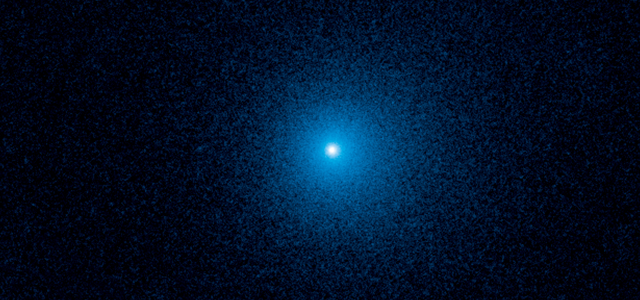Science When, Where And How To See The Giant ‘K2’ Comet Now At Its Biggest, Brightest And Best After A Three Million Year Journey Jamie Carter Senior Contributor Opinions expressed by Forbes Contributors are their own. I inspire people to go stargazing, watch the Moon, enjoy the night sky New! Follow this author to improve your content experience. Got it! Jul 13, 2022, 08:00pm EDT | Share to Facebook Share to Twitter Share to Linkedin This Hubble Space Telescope image shows a fuzzy cloud of dust, called a coma, surrounding the comet .
. . [+] C/2017 K2 PANSTARRS (K2), the farthest active comet ever observed entering the solar system.
The image was taken in June 2017 by Hubble’s Wide Field Camera 3. NASA, ESA, and D. Jewitt (UCLA) Now July’s full Moon has come and gone it’s time to start looking for one of the biggest comets ever discovered.
The largest comet ever found when it was detected by astronomers using the Pan-STARRS telescope back in 2017 (though since surpassed by a “mega comet” ), C/2017 K2 Panstarrs will reach its minimum distance from our planet—about 1. 8 times the Earth-Sun distance—on July 14, 2022. The Virtual Telescope Project has promised to show the event live online , though you can also get eyes-on with it yourself if you have any kind of telescope.
It will get closest to the Sun on December 19, 2022. Right now and through August is the best time to look for it, with any small telescope able to pick it out. Here’s a star-chart to help you find it on July 14, 2022: Here’s a star-chart to help you find 2017 C/2017 K2 Panstarrs on July 14, 2022.
Stellarium It’s in the constellation of Ophiuchus, which is high in the south as seen from the northern hemisphere. Look just before moonrise where you are . It will get closer to the star Saik in Ophiuchus, and very close to it at the end of July.
MORE FROM FORBES VETTED Get The Apple Watch Series 7 At Its Lowest Price Ever For Prime Day Before It’s Completely Sold Out By Kari Molvar Forbes Staff The Best Prime Day Deals Under $25 By Anna Perling Forbes Staff When it was discovered in 2017 C/2017 K2 Panstarrs was 16 times the Earth-Sun distance. It’s a big comet, with the Hubble Space Telescope reckoning it to have a nucleus of about 11 miles/18 kilometers—about 10 times bigger than most comets. Its coma (atmosphere) is about 81,000 miles/130,000 kilometers in diameter.
The “averted vision” technique is what comet-hunters use to see such objects properly. It works because the human eye’s peripheral vision is the most sensitive to brightness, rather than the center of the eye, which sees color. Once you’ve got C/2017 K2 Panstarrs in the crosshairs of your telescope look slightly away from it to really appreciate its brightness.
A mega-comet spotted in 2021 is now the largest ever seen according to observations by scientists using the Hubble Space Telescope. Estimated to be 80 miles across and with a mass of 500 trillion tons, comet C/2014 UN271 (Bernardinelli-Bernstein) has the largest icy comet nucleus ever seen. It’s now on a once-in 600,000-years visit to our solar system, but about two billion miles away.
Its closest approach to the Sun won’t be until 2031. Wishing you clear skies and wide eyes. Follow me on Twitter or LinkedIn .
Check out my website or some of my other work here . Jamie Carter Editorial Standards Print Reprints & Permissions.
From: forbes
URL: https://www.forbes.com/sites/jamiecartereurope/2022/07/13/when-where-and-how-to-see-the-giant-k2-comet-now-at-its-biggest-brightest-and-best-after-a-three-million-year-journey/



